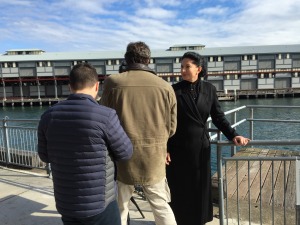News
Heartlands and Headwaters: John Wolseley at the NGV
Jun 25th
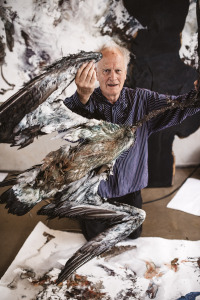
Portrait of John Wolseley, supplied by NGV
John Wolseley is one of Australia’s most extraordinary landscape artists, and if you’re in Melbourne you can catch his landmark exhibition, Heartlands and Headwaters, at the National Gallery of Victoria until September 20, 2015.
I interviewed Wolseley regarding Heartlands and Headwaters, and the transcript follows.
First, a little background about the project from the NGV:
For four years, artist John Wolseley has roamed the coastal floodplains of the Northern Territory through to the glacial lakes of Tasmania, exploring and recording in exquisite detail the diverse wetlands of Australia. The works he has created will be revealed at NGV Australia, 11 April 2015.
This series of eighteen evocative works on paper, many of them monumental in scale (up to 10 metres in size), detail the geographical features and unique plants and animals of these wetlands in works characterised by minutely-observed drawing and rich watercolour washes.
Many works combine collage and unusual markings made through burying works or hoisting large sheets of paper across the charred remains of burnt tree trunks and branches. Through this ‘collaboration’ with the natural environment, Wolseley subverts traditional approaches to the depiction of landscape and seeking to give the natural world a more active presence in the work of art
‘Heartlands and Headwaters celebrates Australia’s unique and diverse natural environment,’ said Tony Ellwood, Director, NGV. ‘Wolseley’s work is not only of great beauty, but also demonstrates how depicting the landscape has become an important form of activism’.
The mangrove swamps of Roebuck Bay in Western Australia, the flood plains of the Gulf of Carpentaria in the Northern Territory, the Finke River in the Simpson Desert and the sphagnum swamps of Skullbone Plains in central Tasmania are just some of the sites detailed in these impressive works.
Commissioned by Sir Roderick Carnegie AC, these works celebrate the beauty of the Australian wilderness and encourage an understanding of the significance and environmental fragility of these remote and little-known sites.
Here, then, is my interview with Wolseley.
Sir Roderick Carnegie once commissioned work from Fred Williams. Did you meet Williams?
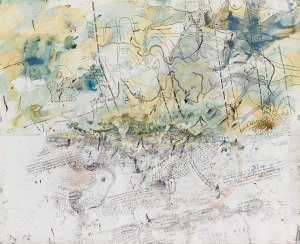
John Wolseley
History of the Whipstick Forest with ephemeral swamps and gold bearing reefs 2011 (detail)
watercolour, charcoal, pencil and on 2 sheets
(a–b) 233.5 x 286.6 cm (overall)
Collection of Sir Roderick Carnegie AC and Family
© John Wolseley
What’s rather lovely is that I saw quite a bit of him. I came here (to Australia from the UK) in 1976, and when I first met him he sort of pointed me in certain directions of which landscapes to look at and things like that. I was laughing to myself the other day that I was drawing some grass trees and I suddenly remembered that he said, ‘you have to go and look at grass trees’.
Did you know each other well?
We had some really good talks. One thing he said to me, which was really nice, was something like, ‘the way you draw the really tiny things of plants and insects and so forth, I think you’re on to something very special there’, he said.
Your interest in ornithology and natural history? Did that happen as a boy in England?
I think I became a passionate little boy naturalist when I was sort of six onwards, because I lived on a farm on the edge of Exmoor, so I could spend all day wandering around in the forests and rivers and things. I think it all started then. And I was sent away to boarding school. I had various pets. I had two different kinds of voles and three different kinds of field mice, snakes, lizards and salamanders and also giant tropical moths which I bred at school in London.
There’s a book I found when I was 13 called Giants Moths of the Jungle. You can buy the eggs. So I had bright green caterpillars with tassels and things like that. In the carpentry department I made a special cage.
This love of animals goes right back. Did your parents live on a farm in Exmoor?
It was the remains of a very old estate and there were two wonderful Shire horses used for ploughing and also doing things like getting the hay on wagons. It was ridiculously Medieval. Funnily enough my father was an artist and one of his friends was an artist called Alfred Munnings. So I used to see a bit of Alfred Munnings, and I even drew a horse when I went to art school and he gave me some tips. Apart from Stubbs, (Munnings) would be the most famous painter of horses, racehorses and hunting horses.
To carry on why I’m interested in the natural world, I ran away to Paris and studied etching and engraving with S.W. Hayter. He was a very inventive chap. He did the kind of etching which is called the viscosity technique. He printed for lots of artist like Miro and Roberto Matta, and when I was 20 I helped Miro print his etchings. He was absolutely the sweetest little chap, and he’d say things like, ‘oh, do you think this is any good?’ And one day he came into the studio and he’d picked up a rhizome from some kind of reed that he’d found in the Bois de Boulogne, I think, and he brought it in and he said, ‘this is where it all starts’, he said.
Getting back to your exhibition, Heartlands and Headwaters. This has occupied you for four years?
The main thrust is stuff I did over that four years. Where it’s a very unusual show is I have a method of working in the bush. I have about 20 different methodologies or systems which range from frottage to making scientific diagrams of natural phenomena.
The techniques are so interesting. There is a video of you inking up the carcass of a pelican and smacking it on to your paper.
I suppose they’re just one of many systems in which I find ways to collaborate with the actual physicality of the plant or tree or rock. They’re different ways of narrowing the gap between the artist and the actual artwork.
(On a moonlit night in the Gulf of Carpentaria, Wolseley dipped a sheet of paper in the sea while the coral were spawning.) I lifted them up slowly, and there they were, sitting there on the paper like a sort of aquatint. Really beautiful.
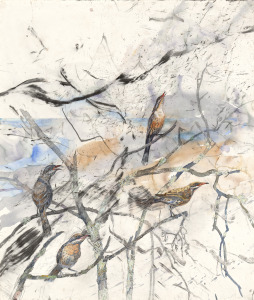
John Wolseley
After fire – spiny-cheeked honeyeaters at Lake Monibeong 2009–11 (detail)
watercolour, charcoal, pencil, gouache and brown chalk
(151.7 x 128.9 cm)
Collection of Sir Roderick Carnegie AC and Family
© John Wolseley
Did you ever think you would become a naturalist rather than an artist?
Um, no, I’ve always said that I’m a pretty wonky scientist.
The other technique you use is where you take the paper out of doors and allow the bush to draw itself with the charcoal after a bushfire. Or you might even bury the paper and retrieve it later.
The burying paper thing’s been going on for about 20 years. But the frottage, the actual moving the paper against trees, started when I was artist in residence at Sydney Grammar School. It was when those big fires had happened in the Royal National Park. That all really started then. I should think it was probably 14 years ago.
It happened accidentally when the drawing I was doing blew off the easel and landed on some kind of burnt hakea or banksia and I thought, ‘the drawing they’re making is better than the drawing I’m making’.
It takes a certain amount of letting go on the part of the artist?
Yes, I think that’s a good point. You could say that a lot of art is the artist composing mental constructs on the paper. Half way through that you might have Jackson Pollock. That I see as half way between imposing and allowing the natural world to reveal itself. And the thing about just throwing bits of paper in the wind and letting them bounce around for six months in the desert wind is the ultimate release of one’s own controlling instincts and allowing the bush to take over.
The paper sometimes couldn’t be found when you came back for it?
About 30 per cent of them get lost; I can’t find them. I was once lying on my back when I’d done all this throwing about, and I looked up and saw a wedge tailed eagle incredibly high up, and then a bit above it were three of my frotts, as I call them, sail around in a kind of whirly whirly. It was quite clear that my artworks were going up and up and up and would probably disappear.
What of the pieces of paper that you do retrieve?
They had, as it were, done their own research and registered the charcoal fingers of all the different trees in such a way that I can actually point to a group and say, ‘these ones were done by a slender leafed mallee and these ones it was probably up against a banksia’.
Elizabeth Fortescue, June 25, 2015
Marina Abramovic in Sydney for her Kaldor Public Art Project
Jun 24th
Marina Abramovic is in Sydney for the duration of her Kaldor Public Art Project, Marina Abramovic: In Residence. That means this city, until July 5, is playing host to one of the most famous artists in the world.
When I met Abramovic at Pier 2/3 in Walsh Bay on June 5 this year (2015), I found her to be personable, warm and only too pleased to enunciate her artistic methods and philosophies.
It was chilly, so we retreated to her lovely room overlooking Walsh Bay. Here is the interview:
I would like to concentrate on the John Kaldor project you are doing in Sydney. What will be your role?
First of all this project’s different than many other projects we’ve been doing in relation to the Abramovic Method because here we also have the artist in residence which I didn’t have before. So the project is separate two parts but they’re connected. The first part is really working with the public and I feel like I’m conductor, of energy basically. I give them the tools; they should interact with these tools, and to see how they can use any of this experience in their own daily life, and it doesn’t matter if they are teachers or politicians or they’re farmers or they’re any kind of profession you can imagine, because some of this experience can be used in any kind of profession you are in in your real life. And a part of this we have residency program which we ask the artists to participate in this Abramovic Method every single day for 12 days and they create this as a conditioning for their own work. So they see how that actually can help them for their concentration, for pushing their own physical and mental limits, for creating the different type of perception, the willpower and so on. So that’s the base. So we see two results. One work with the general public, and one work with someone who is really artist and creative person. So I’m kind of managing all these things. But in the same time I have two very important helpers. Sophie O’Brien who is Australian. She was curator at Serpentine and she curate my show 512 Hours. And I specifically invite her because she knew Australian scene much better than me. That we together look into the applications and choose the artists for the residency program. She will be one of the leading and curating the residency program. But I will interrupt with artists, I will talk daily with them and also give the opening speech. And then Lynsey Peisinger, who is right now auditioning facilitators and also training them to work, because if we have a few hundred people there, I can’t talk to every single person. We have to have facilitators who are trained properly who can actually lead this workshop to have the best success.
So the workshop have different parts. The first thing that happen is you have to leave your watches, your telephone, computers in the locker, so you get kind of free time for yourself. And then after that you are given headphones to block the sound completely. Now you are without technology and without hearing. You are just in silence. And then you start doing these exercises. And the different ways how you want to do, you are pretty free to manage. The one is slow motion walk, another one is rice counting, eye gazing, lying down and looking at the colours. So they’re all different exercises which I train myself through my career. And many others. But specifically these, because they are the more simple ones but also the most efficient that everybody can do in his own life. And to me, idea is how to ritualise our daily existence, how to find the space of silence inside yourself, how you can deal with this, because we live in very disturbed time and there is no time for anything and the war is everywhere and we have to look for the different peace and awareness and the only way to change is to change consciousness.
How long did it take you to develop the exercises?
About 40 years! You know, I also believe the most simple things are the most efficient. But I went to so many different cultures because I always feel I am kind of bridge between East and West because I am born in Balkan and I always believe Balkan is kind of bridge between these two type of worlds, and I understood what’s wrong in the west and I was looking for some answers from the east. People don’t understand much, especially here in Australia, how important for me was living almost one year here with Aborigines. This was essential for my work. I learn so many things about presence, here and now, about temporality of our life, about the connection to nature and so on. Right here in Australia my entire view on the world changed. So that was very important history. And coming back now is such nostalgia and I really have this all memory back how it was. Because the hidden nature is incredibly powerful. One thing is the city but just going to outback, going to place where you just see the earth, the sky, it’s just incredibly important.
Ian Howard facilitated you doing that trip to the desert.
Yes. Nick Waterlow who actually give us the letter that we have to bring to Phillip Toyne. Phillip Toyne was a lawyer in those days living in Alice Spring and he was busy with the Aborigine land rights and I remember going to Phillip Toyne and he say ‘what do you want, you want to be like another bloody tourist want to take advantage of the Aborigines? Get out of here.’ And he throw us out. And then he said to us, ‘if you want to do something for them, then let me know’. So he literally won’t to talk to us, and he was very, very angry. And then we left and then we asked for the grant of the Australia Council which we get the year after. And we get the grant, we got second hand Jeep, we went to Alice Spring and we say ‘Philip we are here, what we can do?’ And he was so surprised that we went back, and he say, ‘OK now we’re going to talk’. He was making the book on the land rights, and I could do photography and design the book, and all I could make them up, so territory, so we both help for like two months in Alice Spring doing this and after we done he say, ‘OK, now I give you permission, now you can go’, and this is how the beginning of this. It was really, really important. We invite Aborigine medicine man to come to Amsterdam and do performance with us which really happened. We had the two of them and then one. It was such important. We really established the friendship with them. Andrew Crocker was another man, he was the first one who brought canvas to the Pitjantjatjara, the tribe, and actually helped them start painting. I was right there. At the beginning of all the starting of the Aborigine artist doing things. So that period of my life was very important for later development of my work.
Did it give you a connection with nature?
Connection with nature but also Aborigine ceremony is the way of life; they actually live through ceremony and they don’t have physical possessions, they don’t care about possessions, they just live in the present. And that’s for us the base of performance art because performance art is immaterial form of art. You have to be there to experience physically. You can’t just, like a painting you put nail on the wall you hang the painting, next day it’s there. Performance is not. If you’re not there, you miss it. And then is immaterial form of art, because it’s something that you have to experience, you have to feel, you can’t touch it, you can’t have it, you can’t hold it. Aborigines are very similar.
Did you witness ceremonial events in the desert?
First of all, lots of interesting things happened. Oh God, I could write just a book about. Ulay was living with the men and I was living with the women because they were strictly always separated. With women I was doing lots of things with the dreams because they played their own dreams. There would be always older woman in the morning that come on the hill and with stick she would draw the dream and we all have to play her dream. And If there’s 10 women in the tribe we will not finish all day the dreams. So next morning there will be more dreams and more women from last night so there will be endless dream actually re-enacting which was so beautiful. And we had a certain early initiation, not a very high one, and this was like, it’s lots of very strange stories which you can’t even explain because they’re supernatural. It’s another world. But anyway it just influenced my life very much.
Who went out there to meet Phillip Toyne?
Ulay and me. Just two of us. With the letter of Nick Waterlow, which is so tragic what happened to him. I can’t believe this. I remember going with him, we went to the market and buy spices and cook the dinners and it was so wonderful. And another person I really want to see is Mike Parr which I love. Such important artist in my point of view. I love his work and he was an early performance artist and he was such a great, you know. And when we came to Australia in 1979 we slept at his house. I remember saying my God this is the end of the world. (laughs). Mike is lovely and his wife, all the family are really nice.
What is your hope for this project? That it will have an on-going effect?
You know, the thing is after I finish Artist is Present for me was very important, what is my legacy? When you came to a certain age, and I am next year 70, it’s like so much age, what you do? And I was not interested in creating a foundation. Like most of artists create a foundation to protect their own work. But my work is so immaterial, so I was thinking I would like an institute, something that really could help young artists with the residency programs to develop their work but also to archive the performance heritage. Because there’s so few performers. There is hardly anybody my age who’s still performing. So I really feel that preservation performance art. Because performance art when it’s really good performance can have an incredible transformative energy and that’s something that other art is not the same because this is living art and this is why it’s so hard to be mainstream art, it was always non mainstream, and only recently which I really hope I contribute to become mainstream, and is now in the museums and people can look seriously. It took me 40 years to actually come to the position that people can listen to me, because nobody was even thinking this could be take serious this form of art at all, it was more like entertainment. So I think the performance art is serious business. So I wanted to work in institute to deal with the idea of how we can see the future, how we can see connection with art, science, technology, and what is the future of art today, and what is the function of an artist today. Because this old fashioned way of the artist who be drunk and full of drugs and then create the work. We have so much more duty to really contribute to society because our society as it is now is not good, we have to do something , and artists have to in their own way create work who can enlarge the consciousness, who can really see reality in different way. Ask the rights questions, and to reflect the future. The good art predict the future. This is why institute is just about all this, and my contribution is to create a method that can be like a base for the people to start reflecting on their own self. Simple things, like what is your function in being born on this planet. Just understand the temporality of our existence, which is so important because we always behave like we’re forever, but if you include the idea you can die any moment any life, then you understand that actually you have not much time, and you should not spend time with bullshit. Really focus. That’s the idea that performance can bring this kind of awareness.
Are you hoping that a lot of children come to your Sydney project? (It is open to people of 12 and over.)
You know what I am incredibly pleased that I am one of the few artists today in the world to have extremely young public. And somehow my public is not any more art public. It’s became mainstream public. After Artist Is Present something emotionally happen, that I start having the type of public who normally don’t go to museum but they come for this experience because this experience really talk to them. This kind of the method which I’m offering here, it would not be possible 10 or 15 years ago. It was not ready but now we are so lost, and we need now more than ever. And this is right time and I really want, for me the young people is the future, they’re the ones we have to address. My generation, it’s too late! The youngest that can be in this method is 12, so my public’s from 12 years old on. And when I give speeches I have this incredible young people come in. I just want to show you one image that really talks to you. (She shows me lots of images of young people, and of other ages, with their headphones on just lost in themselves with their eyes closed.) You have these images that really touch my heart, because I know it’s function, I know it’s working. We’re talking three generations (in the picture there are three people standing together holding hands and lost in reverie). They’re completely in themselves. This is something I am so proud that I can give them the tools that bring them to this point of concentration. This kid never had headphones without coming from them unbelievable loud music. You know, when I put headphones on this kid he said to me, ‘but doesn’t work’. I said, ‘exactly, doesn’t work. This is silence’. He never understood what means silence. It’s simple. I ask them to count the rice, I ask them to walk slowly. It’s the simplest you can imagine but we forgot simplicity. This is all about going back to simplicity, and the people all get there and they get there in different ways. I live for this; it means my purpose on this planet is worth it.
In your 1974 performance, Rhythm 0, you stood in a room and allowed the public to do whatever they wanted to you, with the aid of 72 objects on a table. The objects included a knife and a gun and a bullet. (Members of the public cut Abramovic and one loaded the gun and pointed it at her.) Why didn’t that put you off people forever?
It’s a really interesting thing, I’ve realised now because I’m much wiser than I was then, that I actually wanted to prove that performers, because we’d been so much criticised that we are masochists, and sadists, and performances are just voyeuristic, I was completely dressed, and I didn’t do anything , very calm, and the public was the possibility to be gentle to me and to be cruel, and they choose to be cruel, so it’s not me who is masochist and sadist, it’s the public. And I also understood that if you give the public tools to put the spirit down, they do. But if you give them tools to lift the spirit, they do something else. So in The Artist Is Present, I actually bring the best out of the public. And in Rhythm 0 I bring out the worst.
The potential for harm has reduced over the years in your performances. In the Kaldor project, it is gone.
I don’t need any more. I think it’s about bring the spirit up because it’s so much easier to bring spirit down.
Elizabeth Fortescue, June 24, 2015
Juz Kitson in the Redlands Konica Minolta Art Prize at the National Art School: “It’s not about the shock factor, and never has been”
Mar 30th
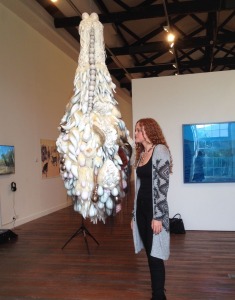 Juz Kitson was selected for the Redlands Konica Minolta Art Prize, on now at the National Art School (until May 23, 2015).
Juz Kitson was selected for the Redlands Konica Minolta Art Prize, on now at the National Art School (until May 23, 2015).
Kitson’s work, titled Something Sacred, is a mad bouquet of strange, seemingly half-formed, animalistic objects. It is suspended from the ceiling and hangs clear of the floor, globular and vaguely confronting. Artist Sophie Cape selected Kitson to show with her in the Redlands Prize, which was curated by artist Tim Johnson.
Kitson was selected to exhibit in the 2013 Primavera exhibition of young artists at the Museum of Contemporary Art Australia.
She grew up in Sydney but lives in the Yarramalong Valley.
Here’s my interview with Juz Kitson:
Elizabeth Fortescue: Sophie Cape selected you as the artist she wanted to show with. I couldn’t imagine two more different artists.
Juz Kitson: Well, that’s the thing. When Soph approached me it was at the beginning of the year and we’ve known each other for about six years. We studied together at the NAS but about a year apart. Our work is very different aesthetically, but we both have this burning desire to create and to challenge our physical being in the type of work we do. We both work in the Australian landscape. The constant collection of bones and using the environment to not only physically inspire the work but also taking resources from the immediate environment. For me it’s important. I spend a lot of time in the central west like Hill End and Broken Hill, physically going out and collecting road kill and taking different animal carcasses back to my property on the Central Coast, putting it on to the ants’ nest and letting the ants eat away at the flesh and letting them be weathered by the extremes of summer and winter. In terms of that we share a lot in common, but the aesthetic is very different.
You also share a Chinese connection.
I think she once did a Chinese residency. I have a studio in China and I’ve been working there for four years and developing my own practice within a traditional porcelain city which has been producing for over 2000 years.
That’s incredible.
It’s phenomenal, working alongside artisans. Facilities, mould making, slip casting, PVD (physical vapour deposition) which is a form of chroming, different techniques that are just inaccessible to me in Australia. So I create the foundation of the works while I’m in China.
It’s amazing I’m back five years after graduating at the NAS. NAS was a huge influence in that because they gave me a residency in partnership with Tsinghua University. I went over and spent three months working in art and design (department) of Tsinghua. And inevitably things just evolve and happen. You’ll meet a curator and a week later I’m having an exhibition at 798 art district.
(Kitson was also influenced by the Chinese performance artist Lin Tianmiao.)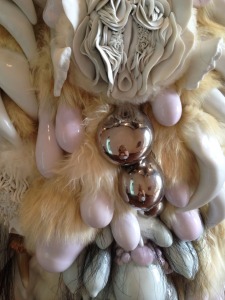
I got in touch with her and asked to be a studio assistant. She let me live with her in her home on the outskirts of Beijing. I lived upstairs and worked in her factory with 25 other female artists, no English, 11 hours a day, seven days. Towards the end she was quite interested in what I was doing and said I needed to go to the ancient porcelain city, Jingdezhen.
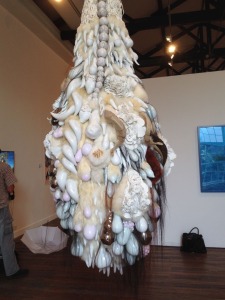 (Kitson first went to Jingdezhen in 2012.)
(Kitson first went to Jingdezhen in 2012.)
It was inevitable that I end up there. I spend half the year there. I can’t get enough of it.
Can you talk about Something Sacred?
This piece was specifically made for the Redlands. I wanted a sense of it being a still moment, that it is going to start breathing. Or bite you or pull you in. By taking something like the horns and road kill, lifeless and inanimate, but to give it new life. And there is a sexual connotation to a lot of the pieces. This one’s quite subtle in terms of the previous work I’ve made. it’s not about in terms of shocking. I want the work to quietly provoke, and people to be drawn to it, or inspired but also repulsed. But quietly. It’s not about the shock factor, and never has been.
Nature has always been a huge influence. I remember as a child always collecting leaves and sticks and constructing pieces out of that. There’s always been an absurd, obscure fascination with even insects.
David Walsh of MONA bought your work?
In 2009 I was half way through the finished installation for my honours project and Emerald Fitzgerald invited David Walsh to come by my studio unexpectedly. He walked into the space and saw the work unfinished. Within four minutes he said ‘how much?’. That was really the pivotal moment.
You were censored in Art Dubai?
They took down nine objects out of 68 objects. Initially I thought it was the form being sexually suggestive, but it was the hair being classed as erotic.
Elizabeth Fortescue, March 30, 2015
John Olsen in painterly conversation with Arthur Streeton at Mosman Art Gallery
Mar 20th
Sydney Harbour, by Arthur Streeton, 1895
It was wonderful to see John Olsen, one of Australia’s oldest living masters, on top of his form at the Mosman Art Gallery this week.
Olsen had made the special trip from his Southern Highlands home to present his painting, titled The Rolling Sea and That Streeton Painting, 2014, as his gift to the gallery.
Exactly why Olsen made this generous gesture, or even created The Rolling Sea in the first place, dates to 2012 when Sydney benefactor Neil Balnaves gave 16 valuable Australian Impressionist paintings to the Mosman gallery.
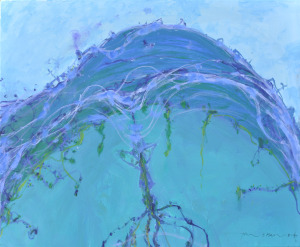
The Rolling Sea and That Streeton Painting, by John Olsen
Olsen had been invited to the celebration surrounding the Balnaves gift, and immediately fell in love with the painting reproduced on the invitation he had received in the mail.
The painting was Sydney Harbour, 1895, by the great Arthur Streeton.
Here are Olsen’s delightful comments yesterday when he walked into the Mosman Art Gallery and saw The Rolling Sea hanging next to Streeton’s Sydney Harbour:
“That’s delicious! It’s almost edible!”, Olsen exclaimed at the first glance of his picture.
“Oh, that’s lovely. I’m so pleased.”
And then he was off, speaking off the cuff in his charming way, telling assembled media all about the picture with barely a prompt from any of us.
“Have you ever travelled on the Manly ferry? And you get to Balmoral way, and it’s getting near the Heads, and it’s been very rough weather and the Manly ferry ploughs into the sea, and it’s very swirly.
“And you see the difference between the two pictures of course. Streeton’s is very very special. It’s 1895 when Streeton first came to Sydney from Melbourne and he’s in great form. Somehow Sydney rejuvenated him, dare I say after Melbourne. And so he did marvellous pictures of the Hawkesbury River, fabulous pictures, (like) Still Glides the Stream, and he took a vantage point there which still exists today. It’s just something that happens to creative people; they can hit their top and everything they do is bloody marvellous. The point being is that whilst they’re blessed, they don’t know. There’s this area of not knowing. And this is a divine picture. When I first saw it I was completely taken by it. I sent a reproduction of it to Clive James, who has very serious illness, leukemia, and he lives in Cambridge and he’d love to come to Australia and he can’t, and he said ‘I like that picture so much that I’ve put it on my bedroom side table’.
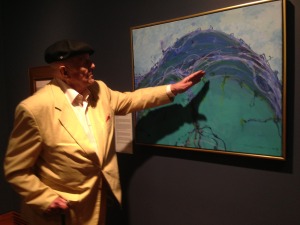
John Olsen at the Mosman Art Gallery, March 2015
“So there it is, and you see it’s just so important and the ferry is just meeting that slight tidal movement at sea and in between there’s a most interesting thing, there’s a big clipper coming in, and there is the modern ship, a steam ship, but they’re still using clippers, it’s 1895.
“Over there is Vaucluse – no houses there! It’s just fantastic. And this lovely touch of the smoke and everything about it is a state of grace. Somehow it’s a blessed kiss that’s taken place. And the sailing boat. But this is another very revolutionary thing. He can see that the best way to do the harbour is to increase by elongation, and furthermore it’s a picture that breaks the chains of us being a colony; it’s completely democratic. Fantastic! It’s such an important picture, and I don’t think Mr Balnaves knew how good it was until I told him. So here it is in the gallery, the right place for it, and it’s in great condition. Later on, have a close look. It’s not mainly blue, there are little touches of violet in it. And the sailing ships are like punctuation marks. And it’s playing again the long, long land mass here. It’s beautiful. And the Heads are again so beautifully painted. It’s a little masterpiece! People should just come, which is the best way to see pictures in the Louvre, just come to watch one picture and hopefully two (indicating his own picture next to the Streeton).
“Whilst Streeton’s picture is planular, this picture (The Rolling Sea) is what I would describe as being in the all-at-once world. Meaning that it’s below the water; it’s the movement of the water, and then the slow sort of turning of the heave of wave. It demonstrates how we in the 20th/21st century view things; that we just don’t really say what I’m looking at is the fact; it’s what lies around it and what surrounds it. And so in consequence this is a kind of reinterpretation. The basic tonality really remains the same, which is what Sydney Harbour is. How luck we are to have the harbour! It’s there to be enjoyed, and I’m very moved that it should be with Streeton. What I’m able to say is that 1895 is a divine period. In 1897 Streeton left Australia hoping to do well in London. He never succeeded. He was sort of there but not there. And he came back, and that innocence had gone. I’m sure you understand the fragility of creativity, and the point of it is the creator himself doesn’t know he has it.

Did you have a copy of the Streeton in the studio while you were painting yours?
Yes, I did, but you see there is the challenge, that it’s no good just following like the pattern of Streeton, even though you can obviously see how much I admired the picture. You have to say, ‘close your eyes. What do I feel?’ And it went back to when we were students at Julian Ahston’s art school and we used to love to go on the ferry when it was rough weather in winter. And we used to love to be not in the cabin but in the front part of the boat, which was a very dangerous thing at the time because the sea often runs over the front of the ferry. And there it was going up and down, and I noticed the ferry in the Streeton picture, of how it was like in that kind of swell is the word, and I thought, ‘now I’ve had that experience, I think I should travel with that’.
Do you have in your mind’s eye exactly where your picture is situated in the Harbour?
Oh well it’s round about the same point as that (the Streeton), slightly towards the Heads.
Your painting is such a generous gift. Why did you do it?
When in love you have no defences!
I think if you live in Sydney the harbour stains your sensibility. There’s something very special about it. It’s the air, and somehow the feeling of belonging to Sydney which is quite different to being a visitor.
Elizabeth Fortescue, March 20, 2015
No more squashed balaclavas: Will Coles is leaving Sydney
Mar 5th
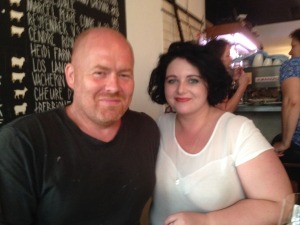
Will Coles and his wife Tiffany Payne-Coles
Will Coles, one of Sydney’s most dedicated art mavericks, is leaving town to live in Spain. All I can say is, “bugger”.
Coles is known to any of you who have ever stumbled across one of his strange and enigmatic concrete sculptures that are stuck down firmly on Sydney’s streets. Squashed balaclavas and drink cans, TV remotes and mobile phones, the small invaders have appeared overnight in shady laneways and odd little parks all over the place. There used to be a squished tetra pack near Royal Prince Alfred Hospital. It was so real I actually reached down to give it a poke. Sure enough, it wasn’t budging. Will Coles had been there, no doubt in the dead of night.
I was lucky to interview Coles a good half-dozen times as I wrote about his exploits and exhibitions for the Daily Telegraph. He also invited me to write a short piece for a brochure on his work.
“Will Coles began exhibiting his sculptures in the back streets of inner suburban Sydney in about 2007, in places where they were pretty much tripped over rather than deliberately sought out for viewing,” I wrote. “Uninvited, raw and unapologetic, they quickly became part of the inner western vibe.”
Coles’ work was taken up by Brenda May Gallery, then Art Equity gallery in Sydney, and he has now had numerous shows. He has also been exhibited in the Holy Grail of Sydney sculpture, Sculpture by the Sea. His appearance there was with a large rendition of those fish-shaped soy sauce containers you get from takeaway shops. But that was many years after he had been an unofficial entrant to Sculpture by the Sea, sneaking into the site under cover of dark to dump his concrete television sets among the invited, sanctioned entries.
Coles’ very witty work, Memorial To The Unknown Armchair General, was exhibited in Hidden, the exhibition of sculpture at Rookwood cemetery. The work is a comfy lounge chair and poof, with a general’s cap on the seat of the chair. All in concrete, I assume. So, as you see, Coles by now is part of the Sydney art scene and has a large and enthusiastic following.
A couple of weeks ago, I met up with Coles and his wife Tiffany Payne-Coles in an Enmore cafe to talk about their plans for Spain. Coles said it felt weird to be leaving when he’s had such a good year. Not only did he marry Tiffany, he also started getting into regional gallery collections, such as Albury, Bathurst and Goulburn, and was shown in the prestigious McClelland sculpture award. “It was the best show I’ve been in, so I was happy with that,” he said.
I asked if the AGNSW had bought anything of his, but no. “I have left stuff outside there,” Coles said. Dropping his art works outside galleries at night has been part of his modus operandi for years.
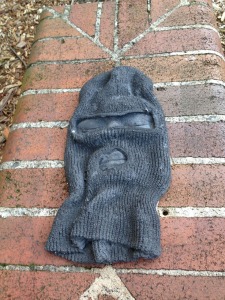
A Coles balaclava
Coles believes galleries such as Tasmania’s MONA and Chippendale’s White Rabbit are the future. He has spent a lot of time at White Rabbit’s beautiful library, a space I only recently discovered myself.
As for Spain, Coles and Tiffany will leave at the end of March and settle in a rural property about two hours drive from Valencia. Coles inherited the property from family. “I’m taking a lot of moulds so as soon as I get there I can start casting,” Coles said.
It looks like Valencia had better start looking out for Coles’ stick-down sculptures, because he aims to continue this habit in Spain.
Coles is excited about living near Barcelona which he describes as a hub for street art. And he’s thrilled to be moving to near Valencia, where amazing street art is everywhere but “no one rates it”.
I was always interested in the fact that Coles’ grandfather was the famous British sculptor Norman Sillman. Coles would consult his grandfather over intractable sculptural problems. I was sad to learn from Coles that Sillman passed away in 2013.
Coles plans to keep exhibiting in Sydney at Art Equity and also at M.Contemporary.
I can only wish Coles and Tiffany a very happy future in Valencia. We will miss them.
Elizabeth Fortescue, March 5, 2015

